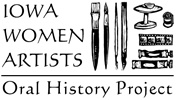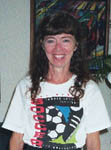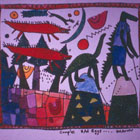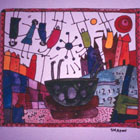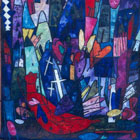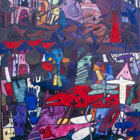SHARON BURNS-KNUTSON
artwork
audio 
- Chemistry, then art (50 sec. | 345KB): listen | read
- Family and art (39 sec. | 274KB): listen | read
- Art influences (20 sec. | 144KB): listen | read
- Being an artist (28 sec. | 193KB): listen | read
- Advice (8 sec. | 55KB): listen | read
audio text
Chemistry, then art
We're a big family sitting there in church, and I used to draw, and people'd say, "Oh, you're so good." And I thought, "Well, that's just something everybody's good at." At that time, to be artistic was if you made things to look like things, and I can do that—and actually still like to do that somewhat. But in high school, I liked math and chemistry and science, and when I started U.N.I., I planned to go into chemistry, and stayed in it for quite awhile. And I liked it. But at that time I was the only girl in all those classes. And I took some art courses, and I liked them. I liked the people there.
I was very involved in the Vietnam War—at least I thought I was. I was young, and we thought we were going to set the world on fire. That's one of the reasons why I went into art. I was with a group of friends—we had very strong feelings about that period. We weren't a violent group or anything, but it was strongly voiced. It affected my work at that time.
Family and art
My husband and my children are very close to my work. My work's very narrative, and it's mostly about my life and my kids. If I were just going up to it and looking at it, it's very colorful. I use a wide color palette. In many ways probably, I'm a storyteller, and very interested in storytelling to children and in my art work. There's a childlike-ness in it. People usually think my work's very happy—and I think it's the colors that I use—but a lot of times, there's melancholy things in there that I address. I don't know if they're very political, but they're usually real close—and maybe that's a feminist thing—they're real close to home and feelings.
Art influences
I'm real interested in Mexican folk art, interested in a lot of folk art—the bark paintings in Australia—and so I think throughout the years those things have kind of fed into my work. I'm real interested in German Expressionist painting—the color—especially southern. I absolutely love that color. And looked at it enough that I think probably, yeah, there's probably an influence there.
Being an artist
It's a lot of joy. One of my sons said, well, he didn't think my job was worth too much. You know, he's a kid. And I said, "Well, I bring a lot of joy to people." And I really think that's true. I do make these kids feel like they're really good, and they like that. It's a real good thing to make people feel that they're good—this is their thing and they're good at it. Even the kids that their coordination might be poor, their design's good, their color's good, something's good there. It's like them. And I think we need joy.
Advice
Anybody in art, I would tell them to be true to theirselves because that's where it's at—that connectedness. And it'll be there if you trust it.
